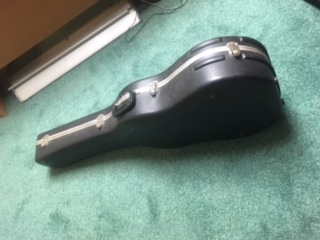AKA: Care & Protection of the Guitar
Opening Scene: My basement studio
It's a band rehearsal and the floor is strewn with the usual array of 1/4" cables and XLR's.
Enter my keyboard guy laden with the keys and he trips on a cable and I watch in horror as my 1976 Les Paul deluxe, which was on a "cheapie" stand,
heads for a faceplant on my linoleum covered, concrete floor. With a knot in my stomach, I approach the guitar, now lying face down, still echoing
the faint sounds of the A11/E chord. Slowly and carefully, I raise her up, expecting the worse...and to my delight, all is well short of a small
dent on the binding. Nothing short of a miracle...thank God.
Needless to say, I've never used a cheapie stand again...and no cords attached until it's ready to rock.
So let's talk more about protection in general. When I was in Luthier college, I remember Bryan Galloup telling us that best place for a guitar is in
the case when not being played. Bryan is the owner of the acclaimed Galloup School of Lutherie and Guitar Repair in Big Rapids, Michigan.
Cases were designed to protect the instrument especially under the rigors of travelling to and from gigs. Not to make a pun, but in my case, it was my
1961 Fender Strat ( which I still have ), and the hardshell case has been a good protector over the years and it was my "moneymaker" for quite a few
years. It did not see a lot of air transport which would have required a much more protective case, but served me well.
The guitar case today comes in many styles and designs and can be anything from Aircraft aluminum style anvil cases, to ABS molded, to steel and pvc
hardshell types, heavy padded-foam filled styles, thick padded-soft sided gigbags, oldstyle chipboard and finally the thin, nylon, zipper styles which I
refer to as dust covers only. They are all capable of protecting the instrument yet all have a specific capability and level of protection. The best example
I can remember is when I started to ride motorcycles as a kid, I bought a cheap $30 helmet and a friend asked me why I bought it. I said it was to save my
bucks. Then he said, "wouldn't you rather spend $100 and save your brain?" Then the bulb went on!
At my shop, I get quite a few guitars in for repair and lot's of them were a result of not keeping them in the case along with damages resulting from
a crappy case. I can almost trace the cause by the nature of the repair needed. It's a no brainer, less protection?...the higher risk of damage.
Here's a few do's and dont's;
Don't- leave an uncased OR cased leaning up against anything
Don't- place loose accessories in the case- use the compartments and even then put them in a cloth or bag.
Don't- Leave your case or guitar near excessive heat, moisture or cold.
Don't- Pack your cased guitar into a tight space, it may damage clasps and locks
Do- Use a protective case that matches appropriately the value of your instrument
Do- Make sure the case FITS the guitar and prevents excessive "freeplay" or movement
Do-Keep your case maintained as you would your instrument. Use proper cleaners and lubricate locks and clasps
Do- Keep the guitar In the case when not being used
As a final note...although solid body guitars are less prone to suffer the effects of "bumps" and jolts remember that acoustic guitars are are
are especially prone to have damages occur based on the construction however...in the world of guitars, treat them all with respect and care.
If you have a guitar that needs repair or restoration, feel free to call us. We treat everyone's guitar as if it were our own...and remember my
friends, "Stay Tuned"
hans






